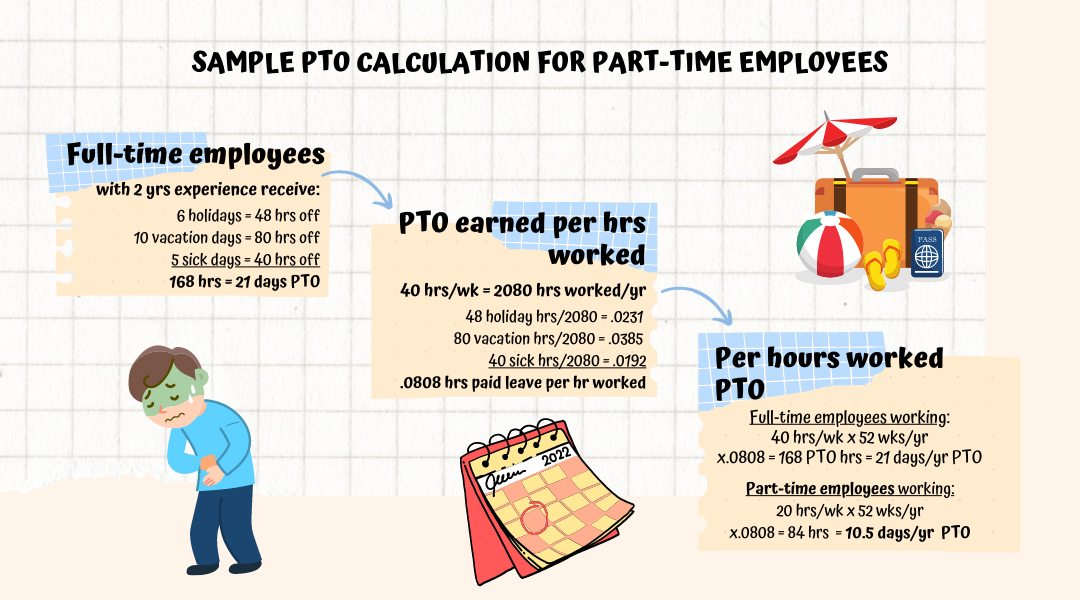How PTO Affects Recruitment and Retention – Part 2 of 2

There is so much more to consider beyond a standard PTO policy.
In this article, I’ll cover other paid leave benefits including sick, bereavement, jury duty, volunteer, parental, family, medical leave, holidays, and part-time leave benefits.
In part one of this series, I discussed using paid time off (vacation and personal paid leave, in particular) to attract and retain quality employees during difficult times. The article focused on providing enough PTO, the viability of offering unlimited PTO, and whether or not to offer consolidated PTO, including sick and other paid leave.
Show You Care About Each Employee
In addition to offering a generous PTO, vacation, or personal leave program, employers should seriously consider offering employees additional paid time for sick, bereavement, jury, parental and other types of leave. When you provide these types of dedicated leave, your company demonstrates that you value employees’ health, wellness, overall financial stability, civic, and familial obligations.
Paid Sick Leave
Some states and localities require employers to provide paid sick leave, but companies generally have the choice to accrue it or front-load/gift it. Sick time accruals often require complicated formulas dictated by state or local minimums, such as one hour of sick leave earned for every 30-40 hours worked. This can be challenging to calculate for part-time employees or when full-time employees work overtime unless you have a sophisticated leave tracking system as part of your payroll or another HR system. Additionally, accrued sick time, when required by law, often requires a carryover of a certain amount of earned but not used sick time at the end of the year.
Employers that front-load or gift sick leave generally have no requirement or expectation to allow the carryover of unused sick leave at the end of the year, and the employer can designate the time as use-it-or-lose-it during the year. Front-loaded sick leave often is more simply defined by legislation as a certain number of days per year, generally no more than 6 days per year. In most cases, employers can require employees to use their sick leave solely for their own or a family member’s illness and discipline employees who inappropriately use it for other personal reasons, like additional vacation time. Employers who don’t operate in states that require paid sick leave should consider offering it to all employees as its prevalence is increasing throughout the United States.
Paid Parental, Family, and Medical Leave
The number of companies that offer paid parental, family, and medical leave continues to increase due to legislative changes and public opinion.
Currently, eleven states and the District of Columbia offer some type of paid family leave. Companies that operate within states that have an obligation to provide paid family leave must consider the optics of not providing these benefits internally to employees that live outside of these states. If you operate in multiple states, it may be wise to educate employees that state-regulated family leave benefits are usually paid by the employee out of their paycheck and not the employer (though some states do require an employer contribution). Offering a voluntary disability plan can be an alternative option for employees that don’t live in states with regulated paid family leave. Be aware that if you offer a company-paid or voluntary disability plan, employees generally cannot earn more than 100% of their wages when they are on paid family or medical leave, including any state-paid leave, company-paid leave, or disability-paid leave.
part-time employees and new hires
As the focus on workplace flexibility has caused remote work and part-time work to become more available, employers must consider what benefits can be offered to part-time workers, as well as what the waiting periods are for new hires using paid time off benefits.
It used to be standard practice not to offer benefits to part-time workers or not allow usage of paid time off benefits within 30, 60, 90, or even 120 days of hire. Times have changed, and our rules must too. I recommend eliminating a waiting period for using paid time off or limiting it to 60 days maximum. It’s recommended not to allow usage of time before it is accrued or earned, as some states do not allow you to recoup benefits paid in advance of earning them upon the termination of employment. Employers must weigh this risk against the burden this can be for new hires or employees that have accruals that reset at the beginning of the calendar year.
Consider offering pro-rated paid time off benefits to part-time employees. Most reliable payroll systems have complex time worked and leave tracking capabilities. It’s easy to calculate your standard annual paid time off offered to full-time employees and then have the system calculate a fraction of that benefit based upon actual hours worked for part-time employees.
For ease of calculation, for part-time employees, you can offer consolidated PTO that encompasses all standard-issued paid leave benefits, including vacation, sick, personal, PTO, and holiday leave. Here’s an example:
Most payroll systems can calculate the paid leave earned per week or per pay period, even when the hours vary greatly. You can keep your standard full-time paid leave policies and just add a part-time paid leave calculation based on actual hours worked if you want to attract more non-traditional employees to supplement your workforce in these difficult times to recruit and retain employees. You would be amazed how much your candidate pool can increase when you include employees seeking only part-time employment based on other priorities in their life.
How much PTO is enough?
There is no federal requirement for a private employer to offer paid time off, but the majority of all employees, full-time and part-time, have access to some sort of paid leave benefits. To be considered an employer of choice and attract and retain employees in today’s market, you must offer generous paid time off policies or some other attractive benefit to employees.
According to the Bureau of Labor Statistics last report on paid sick leave:
- 75% of private industry employees had access to paid sick leave with the average allotment being 8 sick days per year for all employees (private, civilian, and government workers).
- Only 30% of employees surveyed had their sick leave combined as part of a consolidated PTO plan.
Averages for other types of paid leave commonly offered by employers, include:
- Paid Holidays: The Bureau of Labor Statistics states an average of 8 holidays per year are offered to the majority of employees. Fahrenheit’s clients surveyed offer between 6 and 13.5 holidays annually, with the average being 9 holidays per year.
- Bereavement: Most employers offer paid bereavement leave to employees, most often varying between one and three days off depending on the relationship, though often limited to immediate family members.
- Jury Duty: Most employers offer paid jury duty leave to their employees as it is often a minimal expense annually. Some employers cap this allowance at 3 to 10 days per year. Fewer employers are deducting the pay received from the court from the employee’s paid leave because of the burden of administration.
- Volunteer/Community Service Leave: This benefit is rarely offered by employers, but it can be a great recruitment and retention strategy for those companies that have a large community focus and want to attract altruistic employees. When offered by employers, it is often limited between 1 and 3 days paid leave for community service work annually.
- Paid Family Leave: Unfortunately, there are very few reliable statistics about how much paid family leave is available to employees. As of 2021, only 23% of private industry workers had access to paid family leave.
There are many facets to consider when addressing the impact of paid leave policies. There may be local, state, and federal laws that impact your business’ decision. Contact us to move your business Straight. Forward. through these complicated business decisions.
About the Author
 As a Strategic HR Business Partner and Senior HR Consultant, Jennifer Bartlett brings 20+ years’ professional experience in human resources, leadership, administration, marketing, education and law to Fahrenheit. She is dedicated to providing excellent service, counsel and leadership to clients, executives, managers, employees, candidates and customers. Her experience ranges from for-profit, individually owned, private equity backed, publicly traded, start up, public and non-profit multi-state companies (including California). She is a subject matter expert in all aspects of HR including recruitment, retention, on-boarding, employee relations, employee engagement, performance management, training and development, benefits and payroll administration, compensation, legal compliance, and strategic organizational planning.
As a Strategic HR Business Partner and Senior HR Consultant, Jennifer Bartlett brings 20+ years’ professional experience in human resources, leadership, administration, marketing, education and law to Fahrenheit. She is dedicated to providing excellent service, counsel and leadership to clients, executives, managers, employees, candidates and customers. Her experience ranges from for-profit, individually owned, private equity backed, publicly traded, start up, public and non-profit multi-state companies (including California). She is a subject matter expert in all aspects of HR including recruitment, retention, on-boarding, employee relations, employee engagement, performance management, training and development, benefits and payroll administration, compensation, legal compliance, and strategic organizational planning.
